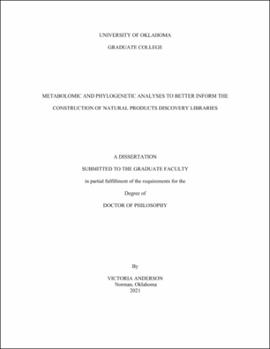| dc.contributor.advisor | Cichewicz, Robert | |
| dc.contributor.author | Anderson, Victoria | |
| dc.date.accessioned | 2021-07-26T18:19:00Z | |
| dc.date.available | 2021-07-26T18:19:00Z | |
| dc.date.issued | 2021-08-05 | |
| dc.identifier.uri | https://hdl.handle.net/11244/330156 | |
| dc.description.abstract | Natural product discovery programs rely on diverse libraries of organisms to provide access to a diverse pool of compounds. The quality and chemical diversity of these libraries are therefore of utmost importance to the discovery efforts. Despite the heavy dependence on these libraries, very little work has been done to determine the best way to construct these libraries. Conventional approaches to library building assumes that the larger the library is the more diverse it will be and the higher the probability of finding novel bioactive compounds. However, these large libraries are unwieldly to both manage and screen. The field of drug discovery would benefit from tools that were able to assess the diversity and to direct future directions for library construction.
Metabolomics is a sophisticated field that attempts to quantify the entire metabolic output of an organism. The development of new metabolomics techniques has allowed the expansion of metabolomics into many different fields, including drug discovery. Drug discovery libraries are at the very heart of discovery efforts and the application of metabolomic tools to drug discovery is an ideal way to investigate the diversity of drug discovery libraries. In an effort to address the lack of concrete guidance about the construction of natural products libraries, we have tested two aspects that are very important to the design of a drug discovery library: 1) the sampling depth required for maximal chemical diversity, and 2) the collection strategy that results in improves the library chemical diversity
While the normal course of drug discovery involves screening extract libraries and then purifying compounds from active extracts based on bioassay data, this does not address the concern of the library’s chemical diversity. Using metabolomic tools instead of those typical in discovery labs may be a more appropriate strategy for answering basic questions about the construction of libraries. The combination of metabolomic tools with phylogenetic analysis allows for an indirect extrapolation of chemical diversity in the library while making use of commonly used tools that are used in library building. In Chapter 3, Alternaria was used to showcase a method to build a library that encapsulates maximum levels of chemical diversity and suggests a strategy to expand into previously unavailable chemistry. This study revealed that chemical diversity is distributed within a genus in an unbalanced manner. Predictive analysis revealed that 99% of Alternaria chemical features would be detected if the collection consisted of 195 isolates. Feature and scaffold accumulation analysis allows an observable level of the chemistry expected from a group of organisms as well as identifying the contribution of new chemistry afforded by including more individuals and leads to building a comprehensive library. These methods can improve the chemical diversity of libraries that are the backbone of natural-product-based drug discovery.
Drug discovery efforts have in the past have emphasized the exploration of diverse environments in the search for novel bioactive compounds. While this strategy has provided new compounds, there is little evidence that new compounds cannot also be locally sourced. The use of metabolomics tools has allowed the examination and comparison of the chemical diversity of groups of organisms that were present in accessible as well as inaccessible environments. The use of traditional metabolomics methods were used to compare the chemical profile of extracts directly, while ecological methods were used to examine which scaffolds were present in both populations or unique to one or the other population. In chapter 4, we use three species of Penicillium that were present in both the sediments of Lake Michigan and soils from the states surrounding this lake to investigate if the origin of the organism confers different chemical production. The metabolic profile of each species showed marked overlap despite the different origin of organisms. The analysis of scaffolds revealed that between 78% and 83% of total scaffolds were shared depending upon species. The community composition of these environments was examined to determine how much overlap is present and while the two environments do share some diversity, there is a community of fungi that is unique to the single environment. The results of this experiment suggest that the value of sampling diverse environments will be predominantly in those organisms that are unique to each space. | en_US |
| dc.language | en_US | en_US |
| dc.subject | Natural products | en_US |
| dc.subject | Metabolomics | en_US |
| dc.subject | LCMS/MS | en_US |
| dc.subject | Fungi | en_US |
| dc.title | Metabolomic and phylogenetic analyses to better inform the construction of natural products discovery libraries | en_US |
| dc.contributor.committeeMember | Rice, Charles | |
| dc.contributor.committeeMember | Schroeder, Susan | |
| dc.contributor.committeeMember | Wu, Si | |
| dc.contributor.committeeMember | Stevenson, Bradley | |
| dc.date.manuscript | 2021-07 | |
| dc.thesis.degree | Ph.D. | en_US |
| ou.group | College of Arts and Sciences::Department of Chemistry and Biochemistry | en_US |
